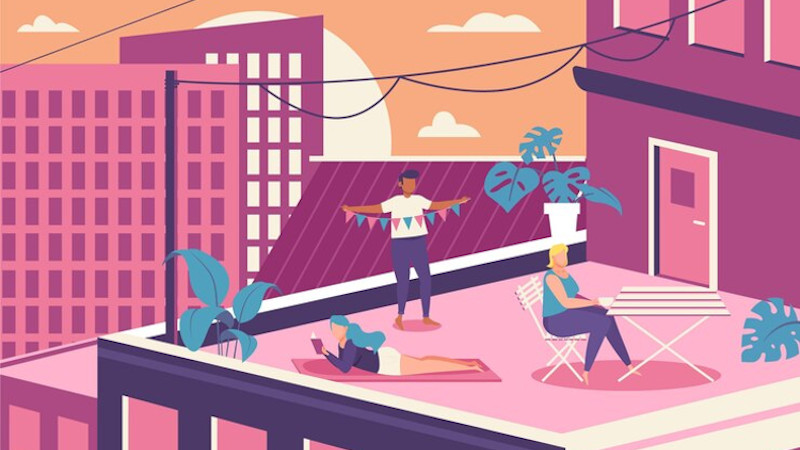The multiplication of services, urban servitudes, regulations, standards, prohibitions, obligations are supposed to satisfy contemporary expectations… An indigestible bouquet to garnish? Part two: aspirations vs inspirations?
New aspirations now occupy the forefront of the architectural scene, well understood by developers considering the solutions they propose, the arguments they develop and engage them. In scattered order: proximity to public transport, the benefits of mobility including all individual vehicles; better than the city of 15 minutes on foot – five minutes by bike – operations are likely to offer the most services necessary for daily life; diversity, or mixtures, of generations, environments, activities, functions, according to the scale of the district, of the building, it is according, in any case preferable to the simplifications of zoning.
To the range of expectations of residents and offers of developers are parameters that are likely to lead to the creation of sustainable neighborhoods thanks, among other things, to the set of technologies dedicated to protecting the planet: energy production to autonomy – useful to reduce individual. bills – water recycling, waste, their recovery, virtues and performance of thermal and sound insulation, and why not decarbonisation of construction.
This bouquet garni attracts, even interests residents when they find what they are looking for, but less so than developers who, by multiplying offers, extend their activities, develop with their partners services that are difficult to do without (large management, measures , administration, neighborhood improvement activity at the apartment, variable geometry aids, video security, electric bicycles reserved for residents, digital on all floors, network control relay, etc.). A whole host of options that gradually give as much value, or even more, to uses than to products and transform the resident into a dependent customer.
Consequently, the complexity already mentioned. One author describes it as a cheese that experts and elites feed to the detriment of individual initiative. True or false, the invention of a global approach to urban affairs leads to the rise of a Mexican army of specialists in their field, struggling when it comes to understanding the final issues that many do not care about.

Hence the need for general management obtained with forceps or saber drawn by the Majors while too often forgetting the infinite resources of urban planning and architecture thought not only in terms of investment, profitability and efficiency but also balance, harmony and sensitive intelligence, which only urban planners and architects, if they are up to the task, manage to realize. And an orchestra.
However, who are these urban planners and architects able to put on the clothes of the master? A thousand scenarios of course, but with constants. Those who work only for public purchases see that their field of activity gradually becomes limited due to its increasing scarcity. Refusing to throw yourself firmly into the market arena reduces the field of possibilities and leads imperceptibly to the desert. Despite culture and know-how, and even if the appeal to the private sector by the State and local authorities hybridizes the situations, the market blurs the boundaries.
Crossing the Rubicon very well but with what advantages? Without exaggeration, it is better to add to your architectural diploma that of HEC or equivalent, enough to see clearly in the political, economic, financial and administrative circuits to put them at the service of the agency and the project. The ideal would undoubtedly be to complete the course with an engineering school, or even – but this is pushing the envelope – with a stint at Polytechnique and Ponts et Chaussées. Evidence? Of course
Then, without being extroverted, deploy sufficient attractions to be heard, listened to, then followed: seek the support of more or less official organizations, of which you must be members or sympathizers to receive the decisive impulse (clans, currents and political parties, Freemasonry , networks of actors); mastery of discourse and dialectics, the flexible use of elements of language to draw your client into a stimulating story, convincing him of the merits of his story thanks to attractive and credible narrative communication.
Convincing, because you yourself are convinced of the seriousness of the issues – above all the future life of the residents – proves to be decisive, not through an oversized ego but thanks to a deep understanding of your sponsor’s expectations, including those unspoken, to vent, to identify , to understand in order to take it further, to transform it into something better than it is. A subtle mixture of seriousness and inventiveness, side steps, transverse analyses, arguments not without delay, but correct, in measured doses, reactive to traps and traps, knowing flexibility, letting go of the branch to keep the. essential that gradually emerges and ends up gaining support.
Despite everything, human relationships are always forged. The intersection of customer and entrepreneur cultures opens up unsuspected perspectives. Striving for mutual respect and dialogue as equals is better than a mutual contempt, dominant, dominated, boss and lackey relationship.
We still need peace of mind. Why deny it, the bottle that long practice and a felt series of achievements coax and calm. This is not always enough. Certainly a solid agency, with efficient and multiple integrated services, is reassuring, but small or large, young or old, it must attract with “the” necessary and decisive skills among all, based on listening, analysis, authority and intelligence: its ability. for synthesis!
Indeed, the multiplication of services, urban servitudes, regulations, standards, prohibitions, obligations, actors, technicians clinging to their Excel tables, the diffusion of intentions requires supervision, the agreement of the partitions, a symphony better than a cacophony. Without irenicism, with synthesis, the urban planner and the architect find a key role lost over the ages, which very few manage to take on, it is true. However, it alone preserves the initial intentions, orders, prioritizes the essential and the subsidiary, changes the issues and the logic, unites the ambitions and makes it possible to aim and finally achieve the goals set upstream.
To build the city, profitability, necessary while it is not shameless, should submit to the aspirations of beauty – this word that no one dares to pronounce anymore – of aesthetic quality and of the urban fabric and of the architecture, the poor relative of almost all the new Zacs of France condemned to Lego assemblies more or less painted with industrialized products.
Who knows how to transform necessary density into an asset? Who knows how to connect the new and the old, the memory and the present, yesterday’s invention with today’s? Who knows the art of perspectives, proportions, scales, subtle agreements, the clever play of volumes in light? Who knows how to intertwine nature and civilization?
To take just one example, a residence that everyone would like to be desirable, more spacious, generous in length, width, height, volume, well lit, extended to the outside, peaceful, airy, is subject to economic and financial imperatives dictate its construction, its price, its plan, model its face, its surfaces, its very economical dimensions (among others the bedroom of 9 m², its ceiling in the reach of the fingertips when raising the arms, etc.) and format its characteristics even before ‘Al. to be conceived Ideal for who? The developer, the architect, the resident?
The internal real estate crisis starting in 2022, well established in 2023, after those of 1991-1995, 2000, 2009, 2012 allows the actors to emit cries of horror and regret the golden age of recent years, suddenly adherents of the eternal ” it would have paid, but it no longer pays “.
Repeated seizures? To avoid them, should we be inspired by what is best and most successful in other European countries, should we invent new economic models that reconcile all the actors in the constitution of the city and put them at the service of those who are there live? A daydream?

